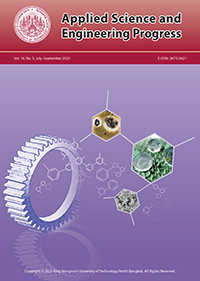Protection of HDG Steel Using ORMOSIL Coatings Enhanced with CeO2(5-ATDT)- Ceramic Nanocontainers
Main Article Content
Abstract
First, we studied the anticorrosion efficiency of the corrosiveness inhibitors CeO2, 5-amino-1,3,4-thiadiazole- 2-thiol (5-ATDT), Ce(NH4)2(NO3)6 in hot-dip galvanized zinc (HDG) steel. The best protection is shown by the compound Ce(NH4)2(NO3)6 among the three. Second, CeO2 ceramic nanocontainers were prepared, which were loaded with 5-ATDT. Third, organically modified silica (ORMOSIL) coatings were produced on hot-dip galvanized zinc (HDG) steel, which was reinforced with CeO2(5-ATDT) nanocontainers. Finally, the anticorrosion protection of these composites was studied using the Frequency Response Analysis (FRA) method, and it was established to reinforce ORMOSIL with CeO2(5-ATDT); inducing the phenomenon of “self-healing”.
Article Details
References
G. Scheer and M. Huckshold, Design and Manufacturing according to Hot-Dip Galvanizing Requirements. Weinheim: Wiley-VCH, 2011, pp. 239–289.
G. Kordas, “Novel antifouling and self-healing eco-friendly coatings for marine applications enhancing the performance of commercial marine paints,” in Engineering Failure Analysis, K. Thanapalan, Eds. London: IntechOpen, 2020. pp. 1–9.
M. F. Montemor, D. V. Snihirova, M. G. Taryba, “Evaluation of self-healing ability in protective coatings modified with combinations of layered double hydroxides and cerium molibdate nanocontainers filled with corrosion inhibitors,” Electrochimica Acta, vol. 60, pp. 31–40, 2012.
G. Kordas and E. K. Efthimiadou, “Selfhealing coatings for corrosion protection of metals,” in The Sol–Gel Handbook: Synthesis, Characterization, and Applications, D. Levy and M. Zayat, Eds. Weinheim: Wiley-VCH, 2015, pp. 1371–1384.
G. Kordas, “Incorporation of noven nanocontainers into corrosion protective coatings on metals to induce self-healing: A multistimuli approach,” in Micro- and Nano-containers for Smart Applications, J. Parameswaranpillai, N. V. Salim, H. Pulikkalparambil, S. M. Rangappa, and S. Siengchin, Eds. London: Springer, 2022, pp. 393–413.
I. A. Kartsonakis, E. P. Koumoulos, C. A. Charitidis, and G. Kordas, “Hybrid organic-inorganic coatings including nanocontainers for corrosion protection of magnesium alloy ZK30,” Journal of Nanoparticle Research, vol. 15, no. 8, pp. 1–17, 2013.
G. C. Kordas, A. C. Balaskas, I. A. Kartsonakis, and E. K. Efthimiadou, “A raman study of 8-hydroxyquinoline release from loaded TiO2 nanocontainer,” International Journal of Structural Integrity, vol. 4, no. 1, pp. 121–126, 2013.
A. C. Balaskas, I. A. Kartsonakis, L. A. Tziveleka, and G. C. Kordas, “Improvement of anti-corrosive properties of epoxy-coated AA 2024-T3 with TiO2 nanocontainers loaded with 8-hydroxyquinoline,” Progress in Organic Coatings, vol. 74, no. 3, pp. 418–426, 2012.
M. L. Zheludkevich, J.Tedim, and M. G. S. Ferreira, “"Smart" coatings for active corrosion protection based on multi-functional micro and nanocontainers,” Electrochimica Acta, vol. 82, pp. 314–323, 2015.
G. Kordas, “Nanocontainers against biofouling and corrosion degradation of materials: A short review with prospects,” Frontiers in Nanotechnology, vol. 4, pp. 1–13, 2022.
N. U. Shehu, U. I. Gaya, and A. A. Muhammad, “Influence of side chain on the inhibition of aluminium corrosion in HCl by α-amino acids,” Applied Science and Engineering Progress, vol. 12, no. 3, pp. 186–197, 2019, doi: 10.14416/j. asep.2019.07.002.
G. Kordas, “Nanocontainers for enhanced protection of HDG steel used in concrete,” Materials, vol. 2, pp. 1–12, 2022.
P. Cecílio, R. G. Duarte, A. M. Simões, M. F. Montemor, and M. G. S. Ferreira, “The effect of cerium nitrate on the corrosion behaviour of electrogalvanised steel substrates, evaluated by XPS and SVET,” Innovative Pre- Treatment Techniques to Prevent Corrosion of Metallic Surfaces, pp. 110–118, 2007, doi: 10.1533/9781845693688.110.
A. M. Cabral, W. Trabelsi, R. Serra, M. F. Montemor, M. L. Zheludkevich, and M. G. S. Ferreira, “The corrosion resistance of hot dip galvanised steel and AA2024-T3 pre-treated with bis-[triethoxysilylpropyl] tetrasulfide solutions doped with Ce(NO3)3,” Corrosion Science, vol. 48, no. 11, pp. 3740–3758, 2006.
V. R. Saliyan and A. V. Adhikari, “Inhibition of corrosion of mild steel in acid media by N’-benzylidene-3-(quinolin-4-ylthio) propanohydrazide,” Bulletin of Materials Science, vol. 31, no. 4, pp. 699–711, 2008.
A. J. Aldykiewicz, A. J. Davenport, and H. S. Isaacs, “Studies of the formation of cerium‐rich protective films using x‐ray absorption near‐edge spectroscopy and rotating disk electrode methods,” Journal of The Electrochemical Society, vol. 143, no. 1, pp. 147–154, 1996.
D. Ho, N. Brack, J. Scully, T. Markley, M. Forsyth, and B. Hinton, “Cerium dibutylphosphate as a corrosion inhibitor for AA2024-T3 aluminum alloys,” Journal of The Electrochemical Society, vol. 153, no. 9, 2006, Art. no. B392.
M. H. Kumar, S. M. Rangappa, and S. Siengchin, “A comprehensive review on metal matrix composites for railway applications,” Applied Science and Engineering Progress, vol. 15, no. 2, 2022, Art. no. 5790, doi: 10.14416/j.asep. 2022.03.003.
P. Jagadeesh, M. Puttegowda, S. M. Rangappa, and S. Siengchin, “Role of polymer composites in railway sector: An overview,” Applied Science and Engineering Progress, vol. 15, no. 2, 2022, Art. no. 5745, doi: 10.14416/j.asep.2022.02.005.
V. Kushvaha, S. M. Rangappa, and S. Siengchin, “Applications of hybrid composites in railway,” Applied Science and Engineering Progress, vol. 15, no. 2, 2022, Art. no. 5768, doi: 10.14416/j.asep. 2022.02.009.
G. Kordas, “Nanotechnology to improve the biofouling and corrosion performance of marine paints: From lab experiments to real tests in sea,” International Journal of Physics Research and Applications, vol. 2, no. 1, pp. 033– 037, 2019.


